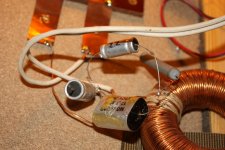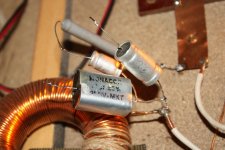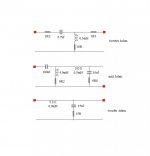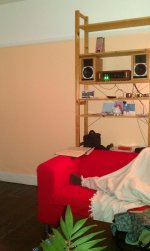Only works or works fine
dont know the difference 😀
nah, its a good 12"
very easy to handle
just not very fancy
but it does what its supposed to do 😉
crossover
still working on that
15uf seem to work better than 12uf, or 22uf
didnt sound good right away
but after a few minutes its getting warmed up
and other components seems to accept it
it will take a while before I know if my ears will accept it 😛
still working on that
15uf seem to work better than 12uf, or 22uf
didnt sound good right away
but after a few minutes its getting warmed up
and other components seems to accept it
it will take a while before I know if my ears will accept it 😛
Attachments
crossover
still working on that
15uf seem to work better than 12uf, or 22uf
didnt sound good right away
but after a few minutes its getting warmed up
and other components seems to accept it
it will take a while before I know if my ears will accept it 😛
I advise to try, Janzen superior Z for the tweeter or audyncap trireference. That helps better than adding the ribbon.
This capacitors are expensive the effect was always audible in my projects, they will outperform any mkt or wima mkp or clearaudio mkp.
I've used fat yellow Maplin polypropylene capacitors for tweeters in the past. Less sibilance than non-polars and better than smaller Solen IIRC. This is the bass rolloff adjustment you are playing with here, I take it? 🙂
This project of yours is really quite inspiring. I love what you have done to the cabinet damping with the braces and cardboard deflectors. 😎
Here's my start point on my old Monitor Audio R300/MD units:
I have braced that flimsy bit between the plastic framed tweeter and the bass unit in the past with a hardwood batten. Always seems to be a weak point in standard IB boxes and I think it makes for a very nasty resonance/rattle. The whole cabinet is lively, as it goes. Hours of fun there for me, I reckon. 🙄
This project of yours is really quite inspiring. I love what you have done to the cabinet damping with the braces and cardboard deflectors. 😎
Here's my start point on my old Monitor Audio R300/MD units:
An externally hosted image should be here but it was not working when we last tested it.
I have braced that flimsy bit between the plastic framed tweeter and the bass unit in the past with a hardwood batten. Always seems to be a weak point in standard IB boxes and I think it makes for a very nasty resonance/rattle. The whole cabinet is lively, as it goes. Hours of fun there for me, I reckon. 🙄
Last edited:
This project of yours is really quite inspiring.
fantastic to hear that 🙂
xo update, and looking like this now
Attachments
Are you doing the crossover by ear mostly? 🙂
I'll disregard the obvious typos on the 6R8 and 8R2 components. It's looking quite Troels Gravesen:
Vifa C17WH-
15R on the bass rolloff doesn't look quite right to me though. It won't be doing anything Zobelish on a 4 ohm speaker. 😕
Not criticising, at all, you understand. Scarcely understand this stuff at all myself.Just grateful I've only got to fiddle with a two-way system. 😀
I'll disregard the obvious typos on the 6R8 and 8R2 components. It's looking quite Troels Gravesen:
Vifa C17WH-
15R on the bass rolloff doesn't look quite right to me though. It won't be doing anything Zobelish on a 4 ohm speaker. 😕
Not criticising, at all, you understand. Scarcely understand this stuff at all myself.Just grateful I've only got to fiddle with a two-way system. 😀
I'll disregard the obvious typos on the 6R8 and 8R2 components. 😀
ups, corrected, thanks
by ear, yes
and knowledge, and experience
and shooting in the blind, that too, yes
maybe some day I will learn to do measurements
but I have to say, the guys using measurements tend to complicate things
and I really never liked the ones I have heard built that way
its like they are not fully finished
always still have to get my fingers in there
theres always, or often, a dilemma with measuremenst
looks good, but may not sound optimal
and when changed to waht appears to sound better, it might look worse on measurement
I have been in that dilemma very often, with other things
not knowing what to trust, measurement, or what appears to work better
it is very very hard to just disregard a measurement, very hard
my honest opinion about measurements is that its a very good guide
in the end I would probably have to switch it off
but I would still like to use measurements, absolutely, no doubt about it
15R on the bass rolloff doesn't look quite right to me though. It won't be doing anything Zobelish on a 4 ohm speaker. 😕
not doing much, no
but phase goes wrong without it
but Im not finished with that resistor
I dont like its that big either
and those capacitors are really the worst crap ever 😉
but with the right signal/source, the sound is surpricingly good
I sometimes hear noices
and look around thinking, what was that
and its just a barely audible bongo drum they obviously thought had been filtered out
but apparently not enough
a bit strange to think that way
but I guess its the way it is
could be a sign of a good speaker
not sure yet
HaHa, yes, a good setup gives you little surprises. I hear noises too. 😉
I think I can see where you're going on that mild inductor/15R resistor. It joins phase to the midrange network, doesn't it? 🙂
Us diyers are best with first order networks really. Fairly predictable if you can keep them away from the fundamental resonance of the unit. I would like the test gear though. I don't even know the Le of my bass unit, so it's all a bit problematic if I can do much with it. Got all the tweeter parameters though, so can go with that to my hearts content.
A simple signal generator and oscilloscope would do me. We used to have a great test bench at one previous workplace. Frequency response, phase, group delay an' all that. But I know what you mean about following your intuition.
The old BBC monitors sounded VERY SMOOTH, and I had a related big Chartwell PM400 reflex setup that was hard to fault and had nice plastic-dome audax tweeters, but do I think those ol' KEF Bextrene units were dead sounding. But there's still stuff to learn from those engineers. 🙂
Just found a pic of the Chartwell's:
Those 12" bextrene bass units were so heavy, you had to turn them upside down every few months to stop the voice coils rubbing!
I think I can see where you're going on that mild inductor/15R resistor. It joins phase to the midrange network, doesn't it? 🙂
Us diyers are best with first order networks really. Fairly predictable if you can keep them away from the fundamental resonance of the unit. I would like the test gear though. I don't even know the Le of my bass unit, so it's all a bit problematic if I can do much with it. Got all the tweeter parameters though, so can go with that to my hearts content.
A simple signal generator and oscilloscope would do me. We used to have a great test bench at one previous workplace. Frequency response, phase, group delay an' all that. But I know what you mean about following your intuition.
The old BBC monitors sounded VERY SMOOTH, and I had a related big Chartwell PM400 reflex setup that was hard to fault and had nice plastic-dome audax tweeters, but do I think those ol' KEF Bextrene units were dead sounding. But there's still stuff to learn from those engineers. 🙂
Just found a pic of the Chartwell's:
An externally hosted image should be here but it was not working when we last tested it.
Those 12" bextrene bass units were so heavy, you had to turn them upside down every few months to stop the voice coils rubbing!
Last edited:
Hardwood is a good choice. Triangles in the corners leading from the bolt holes can work well when the batten would get in the way.I have braced that flimsy bit between the plastic framed tweeter and the bass unit in the past with a hardwood batten.
Don't really want to burst your bubble 😉Us diyers are best with first order networks really. Fairly predictable if you can keep them away from the fundamental resonance of the unit.
First order electrical networks are less predictable than second order ones. Sometimes they will have almost no positive effect, and sometimes they will make the response worse. They cannot adequately prevent a tweeter's excursion from increasing at lower frequencies. Apart from a drivers fs, they can't negotiate its cone breakup very well. Their effect is not always as great as driver's natural differences to begin with.
And you can hardly create a first order crossover using first order networks.
And you can hardly create a first order crossover using first order networks.
I would never claim my xo to be 6db 😉
actually I dont know what it is
and even with meaurements, and from looking at slopes, I would probably find it difficult to tell exactly what kind of xo or order it would be 😕
Your dead right! I was thinking about this, and really the object of the exercise is to brace the box to the bass unit's securing bolts. 4 triangles could be good!Hardwood is a good choice. Triangles in the corners leading from the bolt holes can work well when the batten would get in the way.
In my case, I think the Zobel network on the tweeter should help more than anything. I know what you mean about the rolloff being quite low. As it goes, the MA R300's have a second-order on the tweeter already, so maybe not mess with it too much.
Apropos almost nothing, I'm still grooving over that picture of the old beat-up Chartwell PM400.
An externally hosted image should be here but it was not working when we last tested it.
The recessed bass is very BBC. The reflex holes (not tubes) were lined with draught excluder. The showroom trick was to hold a lighted match in front of the reflex, and when a bass note was hit, voila, the match went out. Quite impressive, and probably why I bought them. Mostly used them for parties, as it goes. But 15" Tannoy's in a simple box were WAYY better. 😀
Don't really want to burst your bubble 😉
First order electrical networks are less predictable than second order ones. Sometimes they will have almost no positive effect, and sometimes they will make the response worse. They cannot adequately prevent a tweeter's excursion from increasing at lower frequencies. Apart from a drivers fs, they can't negotiate its cone breakup very well. Their effect is not always as great as driver's natural differences to begin with.
And you can hardly create a first order crossover using first order networks.
They may mean first order electrical ...... not acoustic
They may mean first order electrical ...... not acoustic
back then, they didnt know this

looks like they have 'potential'
They may mean first order electrical ...... not acoustic
As you can see though, I was talking about single component per roll-off crossovers, not first order electrical or first order acoustic but I chose not to go there.
Well, the BBC had a trick to reduce the Fs resonance a tidge, They put a resistor across the tweeter. 82 ohms on the LS3/5a's T27, IIRC. Wastes power of course.
Troels Graveson does something cleverer with a RLC network. 🙂
Troels Graveson does something cleverer with a RLC network. 🙂
Troels Graveson does something cleverer with a RLC network. 🙂
some think RLC are necessary to make a crossover/speaker work properly
but I dont like them
even when done correctly, and verified to work, by measurements
may sound 'weird', but I dont like to 'push' the driver too much, by using 'tough' xo
I much prefer the 'gentle' approach
and drivers also seem to like it better

not sure I should have said that 😀
You can make your crossover design easier with selection of drive units too. This is a comparison of the £33 Morel Classic CAT 298 and the vented £46 CAT 308, available in 94 and 104mm mount, which uses a bigger magnet but the same replaceable voice-coil/dome:
This is almost a perfect example of how a bigger enclosure lowers the Qts, but given you can do something about the rising inductance with a parallel Zobel RC network, the lower Qts is going to help too. The vent and enclosure also lowers the Fs a tidge and increases efficiency, though the bigger magnet hides that somewhat. You'd guess the vented 308 sounds better too. Thought I'd share...🙂
An externally hosted image should be here but it was not working when we last tested it.
This is almost a perfect example of how a bigger enclosure lowers the Qts, but given you can do something about the rising inductance with a parallel Zobel RC network, the lower Qts is going to help too. The vent and enclosure also lowers the Fs a tidge and increases efficiency, though the bigger magnet hides that somewhat. You'd guess the vented 308 sounds better too. Thought I'd share...🙂
Last edited:
- Home
- Loudspeakers
- Multi-Way
- Classic monitor designs?



